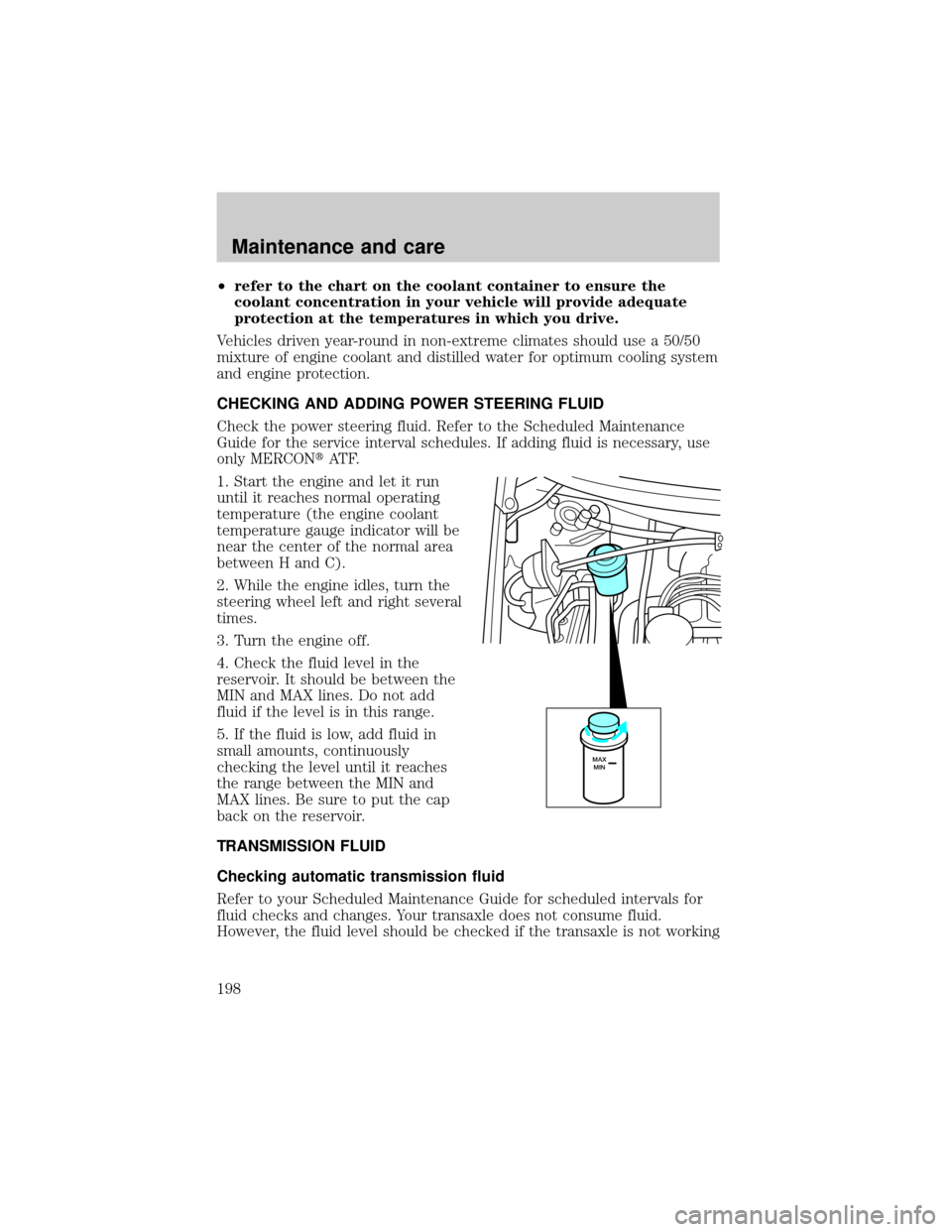check transmission fluid Mercury Villager 2000 Owner's Manuals
[x] Cancel search | Manufacturer: MERCURY, Model Year: 2000, Model line: Villager, Model: Mercury Villager 2000Pages: 256, PDF Size: 2.21 MB
Page 198 of 256

²refer to the chart on the coolant container to ensure the
coolant concentration in your vehicle will provide adequate
protection at the temperatures in which you drive.
Vehicles driven year-round in non-extreme climates should use a 50/50
mixture of engine coolant and distilled water for optimum cooling system
and engine protection.
CHECKING AND ADDING POWER STEERING FLUID
Check the power steering fluid. Refer to the Scheduled Maintenance
Guide for the service interval schedules. If adding fluid is necessary, use
only MERCONtAT F.
1. Start the engine and let it run
until it reaches normal operating
temperature (the engine coolant
temperature gauge indicator will be
near the center of the normal area
between H and C).
2. While the engine idles, turn the
steering wheel left and right several
times.
3. Turn the engine off.
4. Check the fluid level in the
reservoir. It should be between the
MIN and MAX lines. Do not add
fluid if the level is in this range.
5. If the fluid is low, add fluid in
small amounts, continuously
checking the level until it reaches
the range between the MIN and
MAX lines. Be sure to put the cap
back on the reservoir.
TRANSMISSION FLUID
Checking automatic transmission fluid
Refer to your Scheduled Maintenance Guide for scheduled intervals for
fluid checks and changes. Your transaxle does not consume fluid.
However, the fluid level should be checked if the transaxle is not working
MAX
MIN
Maintenance and care
198
Page 199 of 256

properly, i.e., if the transaxle slips or shifts slowly or if you notice some
sign of fluid leakage.
Automatic transmission fluid expands when warmed. To obtain an
accurate fluid check, drive the vehicle until it is warmed up
(approximately 30 km [20 miles]). If your vehicle has been
operated for an extended period at high speeds, in city traffic
during hot weather or pulling a trailer, the vehicle should be
turned off for about 30 minutes to allow fluid to cool before
checking.
1. Drive the vehicle 30 km (20 miles) or until it reaches normal operating
temperature.
2. Park the vehicle on a level surface and engage the parking brake.
3. With the parking brake engaged and your foot on the brake pedal,
start the engine and move the gearshift lever through all of the gear
ranges. Allow sufficient time for each gear to engage.
4. Latch the gearshift lever in P (Park) and leave the engine running.
5. Remove the dipstick, wiping it clean with a clean, dry lint free rag. If
necessary, refer toIdentifying components in the engine compartment
in this chapter for the location of the dipstick.
6. Install the dipstick making sure it is fully seated in the filler tube.
7. Remove the dipstick and inspect the fluid level. The fluid should be in
the designated areas for normal operating temperature.
Low fluid level
Do not drive the vehicle if the fluid
level is at the bottom of the dipstick
and the outside temperatures are
above 10ÉC (50ÉF).
Correct fluid level
The transmission fluid should be checked at normal operating
temperatures 66ÉC-77ÉC (150ÉF-170ÉF) on a level surface. The normal
operating temperature can be reached after approximately 30 km (20
miles) of driving.
HOT
Maintenance and care
199
Page 252 of 256

Clock ..................................48,60,71
Console ......................................101
overhead ....................................98
Controls
power seat ...............................113
steering column ........................86
Coolant
checking and adding ..............194
refill capacities .................197,233
specifications ...................234,235
Cruise control
(see Speed control) ....................82
Customer Assistance ................166
Ford accessories for your
vehicle .....................................245
Ford Extended
Service Plan ............................238
Getting assistance outside
the U.S. and Canada ..............244
Getting roadside assistance ...166
Getting the
service you need ....................238
Ordering additional
owner's literature ...................249
The Dispute
Settlement Board ...................241
Utilizing the Mediation/
Arbitration Program ...............244
Defrost
rear window ..............................40
Dipstick
automatic
transmission fluid ...................198
engine oil .................................189
Doors
door ajar warning .......................9
lubricant specifications ..........234
Driving under special
conditions
through water .........................159
Emergencies, roadside
jump-starting ..........................180Emission control system ..........220
Engine ........................................235
check engine/service engine
soon light ..................................11
cleaning ...................................229
coolant .....................................194
idle speed control ...................201
lubrication
specifications ...................234,235
refill capacities ........................233
service points ..........................188
starting after a collision .........167
Engine block heater .................150
Engine oil ..................................189
checking and adding ..............189
dipstick ....................................189
filter, specifications .........191,233
recommendations ...................191
refill capacities ........................233
specifications ...................234,235
Exhaust fumes ..........................150
Floor mats .................................102
Fluid capacities .........................233
Fuel ............................................212
calculating fuel economy .......217
cap ...........................................214
capacity ...................................233
choosing the right fuel ...........215
comparisons with EPA fuel
economy estimates .................220
detergent in fuel .....................216
filling your vehicle
with fuel ....................212,214,217
filter, specifications .........217,233
fuel pump shut-off switch .....167
gauge .........................................16
improving fuel economy ........217
low fuel warning light ..............10
octane rating ....................216,235
quality ......................................216
running out of fuel .................217
Index
252
Page 255 of 256

replacing ..................................211
rotating ....................................210
snow tires and chains ............212
tire grades ...............................209
treadwear ................................209
Towing ................................162,210
trailer towing ..........................162
wrecker ....................................185
Transaxle
automatic operation ...............155
fluid, refill capacities ..............233
lubricant specifications ..........235
Transmission
fluid, checking and adding
(automatic) .............................198
lubricant specifications ..........234
Trip odometer .............................15
Turn signal .............................10,87
Vehicle dimensions ...................235Vehicle Identification
Number (VIN) ...........................237
Vehicle loading ..........................160
Ventilating your vehicle ...........151
Warning chimes ......................12,13
Warning lights (see Lights) .........8
Washer fluid ..............................193
Water, Driving through .............159
Windows
power .........................................90
rear wiper/washer .....................88
Windshield washer
fluid and wipers ..........................88
checking and adding fluid .....193
checking and cleaning .....207,208
liftgate reservoir .....................193
operation ...................................87
replacing wiper blades ...........208
Wrecker towing .........................185
Index
255